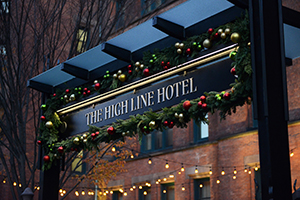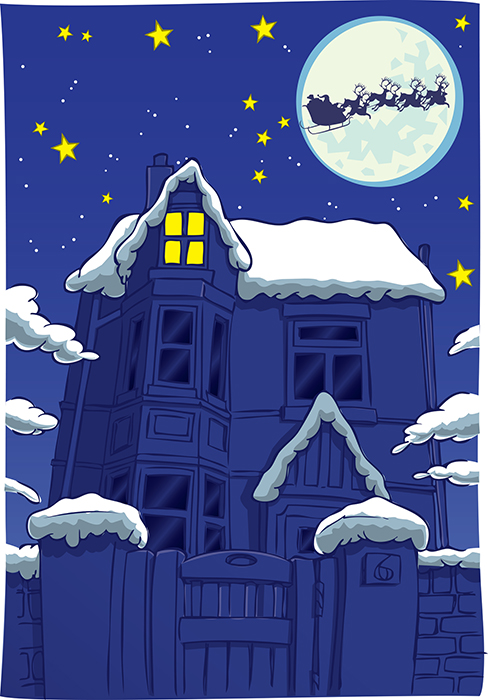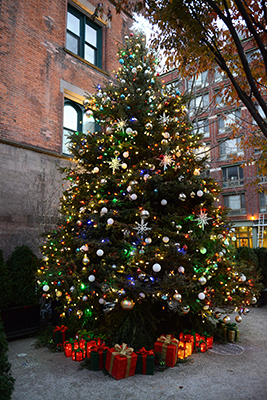THE HISTORY OF ST. NICHOLAS IN NYC
By Clint Brownfield
On Christmas Eve of 1823, Clement Clarke Moore, a wealthy landowner and Columbia College professor, after a trip by sleigh down to the Washington Market on the Lower Westside to buy a turkey, completed a Christmas poem called A Visit From St. Nicholas, to read to his children. He penned the mirthful verse, which would be a significant departure from his great and respected writings in Greek and biblical literature—from a desk at his comfortable, snow-covered mansion, which the family called Chelsea.
At that time it was all about St. Nicholas. Santa Claus, as we know him today, wouldn’t appear on the scene until the 1850s. One of the first artists to depict Santa Claus’s modern image was Thomas Nast, an American cartoonist of the day. In 1863, an illustration by him first appeared in Harper’s Weekly, depicting the jolly and rotund figure.
The Moore’s surrounding farm was well above the city center, which at that time was concentrated from the tip of Manhattan up to what is now Houston Street. The farm was named Chelsea by his grandfather, Major Thomas Clarke, an English officer who stayed in the colony after fighting in the French and Indian War. And this neighborhood, between West 23rd and 14th Streets, from Eighth Avenue to the Hudson River, still bears that name.

To say that the Clarke/Moore families were major Episcopalians would be the understatement of the last few centuries. Clement’s father, Benjamin Moore, was the rector at Trinity Church, where, among other duties, he administered the last rites to Alexander Hamilton after his unsuccessful duel with Aaron Burr. Both Moore and Hamilton are buried in the cemetery at Trinity Church (trinitywallstreet.org).
Clement Clarke Moore would later donate several blocks of the Chelsea estate for what would become and continues to be The General Theological Seminary of the Episcopal Church in the United States, located between West 20th and 21st Streets and Ninth and Tenth Avenues. Today, the seminary shares space with the modern High Line Hotel (thehighlinehotel.com), which each year, lights a tree in his honor and offers readings of the poem for children in the area. At the bar, apple-themed drinks are served as a reminder that the land was originally an apple orchard.
Nearly two hundred years later, the reading of the poem on Christmas Eve, has become one of America’s most time-honored traditions. We present to you the poem in its entirety. Please read it aloud surrounded by loved ones this coming Christmas Eve.

By Clement Clarke Moore
‘Twas the night before Christmas, when all through the house
Not a creature was stirring, not even a mouse;
The stockings were hung by the chimney with care,
In hopes that St. Nicholas soon would be there;
The children were nestled all snug in their beds;
While visions of sugar-plums danced in their heads;
And mamma in her ‘kerchief, and I in my cap,
Had just settled our brains for a long winter’s nap,
When out on the lawn there arose such a clatter,
I sprang from my bed to see what was the matter.
Away to the window I flew like a flash,
Tore open the shutters and threw up the sash.
The moon on the breast of the new-fallen snow,
Gave a lustre of midday to objects below,
When what to my wondering eyes did appear,
But a miniature sleigh and eight tiny rein-deer,
With a little old driver so lively and quick,
I knew in a moment he must be St. Nick.
More rapid than eagles his coursers they came,
And he whistled, and shouted, and called them by name:
“Now, Dasher! now, Dancer! now Prancer and Vixen!
On, Comet! on, Cupid! on, Donner and Blitzen!
To the top of the porch! to the top of the wall!
Now dash away! dash away! dash away all!”
As leaves that before the wild hurricane fly,
When they meet with an obstacle, mount to the sky;
So up to the housetop the coursers they flew

And then, in a twinkling, I heard on the roof
The prancing and pawing of each little hoof.
As I drew in my head, and was turning around,
Down the chimney St. Nicholas came with a bound.
He was dressed all in fur, from his head to his foot,
And his clothes were all tarnished with ashes and soot;
A bundle of toys he had flung on his back,
And he looked like a peddler just opening his pack.
His eyes—how they twinkled! his dimples, how merry!
His cheeks were like roses, his nose like a cherry!
His droll little mouth was drawn up like a bow,
And the beard on his chin was as white as the snow;
The stump of a pipe he held tight in his teeth,
And the smoke, it encircled his head like a wreath;
He had a broad face and a little round belly
That shook when he laughed, like a bowl full of jelly.
He was chubby and plump, a right jolly old elf,
And I laughed when I saw him, in spite of myself;
A wink of his eye and a twist of his head
Soon gave me to know I had nothing to dread;
He spoke not a word, but went straight to his work,
And filled all the stockings; then turned with a jerk,
And laying his finger aside of his nose,
And giving a nod, up the chimney he rose;
He sprang to his sleigh, to his team gave a whistle,
And away they all flew like the down of a thistle.
But I heard him exclaim, ere he drove out of sight—
“Happy Christmas to all, and to all a good night!”



